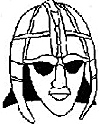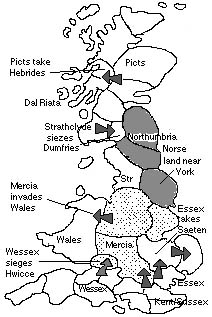
Men sweated beneath their armor as warfare across Britain heated up in the summer months. Perhaps the most hotly engaged was King Coenwulf of Mercia. His armies traded spear thrusts with four kingdoms in three enemy and four of his own provinces.
In June, two Mercian armies tramped across Offa's Dyke into Wales. One laid siege to the capital of the subkingdom of Powys, while the other struck southwards. A third Mercian force shoved the Welsh who had taken the border fort of Dee back into Wales. As summer wore on, the Mercians were met by the Welsh in battles beneath the black hills. Eorl Rowast's army besieging Powys' capital was shattered by a Welsh counterattack and sent fleeing homeward. However, Eorl Heatherbane was more successful in southern Powys. He routed a relieving Welsh army and took the town of Leominster, where he'd cornered a smaller force. These he slaughtered or took captive n the sack of the town.
 On his southern front, King Coenwulf was stymied. Although the engulfed province of Hwicce held out against Wessex siege all summer, a border fort in Chiltern to the north fell to them. Coenwulf's general on that front, Eorl Lwyen, attacked a larger Kentish force marching on Warwick. Lwyen watched in paralyzed shock as the men of Kent rolled up his right flank and destroyed his army. As Lwyen was dragged in chains southward, Warwick was encircled by siege lines.
On his southern front, King Coenwulf was stymied. Although the engulfed province of Hwicce held out against Wessex siege all summer, a border fort in Chiltern to the north fell to them. Coenwulf's general on that front, Eorl Lwyen, attacked a larger Kentish force marching on Warwick. Lwyen watched in paralyzed shock as the men of Kent rolled up his right flank and destroyed his army. As Lwyen was dragged in chains southward, Warwick was encircled by siege lines.
In the east, Mercian penetrated deeper into East Anglia, laying siege to Colchester. It stoutly held out all summer, but Mercian Northampton fell to Essex after three months of siege. Coenwulf had lost his first province. The victorious Essex army raced back to relieve Colchester, and was only a week's march away by summer's end.
The summer of 816 A.D. proved to be the best in centuries for the Britons of Strathclyde. The Cumbrian League's "tour de force" along the eastern coast of Northumbrian Deira and Bernicia drove their ancient enemy to distraction. A Northumbrian army was forced to follow in their path, breaking up its sieges instead of relieving encircled Carlisle or Ruthwell in the north. A bloody assault on Ruthwell's walls in August led to the reconquest of Dumfries by the Britons. When word came that the Norsemen had quit Strathclyde Cumbria and appeared before the walls of Northumbrian York, tidings only got better. King Eanred's woes were the Briton's celebrations. As summer closed, Carlisle remained besieged, though a Northumbrian army was closing in on it.
Celtic infighting among the Scots and Picts grew more bitter as the summer sun hung longer in the far northern sky. The Scots army marching to relieve the Hebrides was frustrated and slowed by the rearguard actions of the Pictish cavalry. As the walls of Ballachulish finally came within sight, news arrived that the capital had fallen to the Pictish tribesmen. In anger, the Scots drew up their battlelines. A fierce day-long fight ensued. The Scots warbands, after hours of slowly driving back the Pictish light cavalry and archers, were broken when the fresh Pictish spearmen pierced through their disordered lines. The tables were turned as the Scots were driven south, struggling to hold back the pursuit of the larger Pictish army. As summer ended, the Scots capital and reinforcements were in sight, and the Dal Riatans readied their weapons again for another battle with the tattooed Pictish tribesmen.
The three summer campaign turns had proven very exciting. Four tabletop battles and a host of sieges had led to three provinces changing hands, so far. Dal Riata, Northumbria and Mercia were all beleaguered, but each had important battles on the horizon in Autumn which could salvage their campaigning season.
More Bretwalda
Winter 815 A.D.
Spring 816 A.D.
Summer 816 A.D.
Fall 816 A.D.
Winter 816 A.D.
Spring 817 A.D.
Summer 817 A.D.
Autumn 817 A.D.
Winter 817-818 A.D.
March and April 818 A.D.
May and June 818 A.D.
Who Won? Part 1
Who Won? Part 2
Who Won? Part 3
Back to The Herald 23 Table of Contents
Back to The Herald List of Issues
Back to MagWeb Master Magazine List
© Copyright 1998 by HMGS-GL.
This article appears in MagWeb.com (Magazine Web) on the Internet World Wide Web. Other articles from military history and related magazines are available at http://www.magweb.com